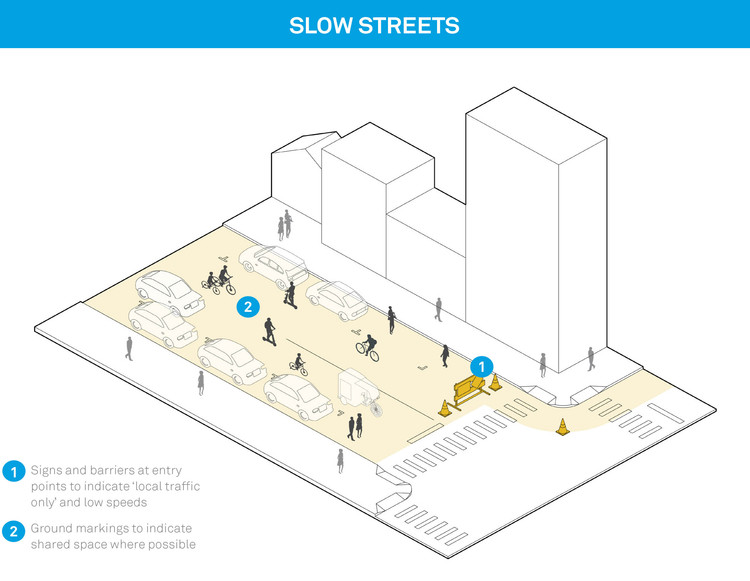
NACTO Releases Streets for Pandemic Response and Recovery in the Fight Against the COVID-19
- Written by Christele Harrouk
- May 25
Share Share
Or https://www.archdaily.com/940245/nacto-releases-streets-for-pandemic-response-and-recovery-in-the-fight-against-the-covid-19 Clipboard"COPY" Copy
The National Association of City Transportation Officials (NACTO) has released guidelines to provide cities with strategies “to redesign and adapt their streets for new uses both during the COVID-19 crisis and in the recovery”. Streets for Pandemic Response and Recovery highlights the most updated street design approaches cities are using, around the world.
Gathering responses of city transportation officials, Streets for Pandemic Response and Recovery is developed by NACTO’s COVID-19 Transportation Response Center. The compiled policies include mainly detailed implementation information about:
- Lanes for Biking & Rolling
- Sidewalk Extensions
- Transit Lanes
- Slow Streets
- Pick-Up & Delivery Zones
- Outdoor Dining
- Markets
Related Article
London Introduces Car-Free Streets as Lockdown Eases

Transportation and transit agencies around the world are leading the response with bold, creative and rapid steps to reshape their streets, and by using their existing assets differently. […] Adaptive use of streets can lead the global response and recovery to the crisis, keeping people safe and moving while holding cities together. -- Janette Sadik-Khan, NACTO Chair and principal with Bloomberg Associates.

Funded by Bloomberg Philanthropies and developed by NACTO, NACTO’s Global Designing Cities Initiative, Bloomberg Associates, Street Plans, and Sam Schwartz Consulting, the initiative provides city officials with new resources, in the fight against the coronavirus. Constantly “revised and expanded to include new strategies, address changing conditions, and provide the best possible information on each design practice”, this information aims to “keep essential workers and goods moving, provide safe access to grocery stores and other essential businesses, and ensure that people have safe space for social/physical distancing while getting outside”.

In developing Streets for Pandemic Response and Recovery, NACTO looks to make it easier for cities everywhere to respond faster, innovate better, and support their residents in more equitable and sustainable ways. This pandemic has laid bare and amplified structural inequities and pre-existing socioeconomic disparities across communities. Transportation leaders and practitioners can use streets to chart a healthier and more equitable course for the future. -- Corinne Kisner, Executive Director of NACTO.

The new resource provides technical assistance, information on implemented examples from around the world from the planning, public engagement, to the design and execution. Underlined cases showcase converted curbside lanes into expanded sidewalks or bike lanes, designated sidewalk or street space for cafe seating or outdoor dining, and the introduction of pedestrian-only or slow and shared streets, amongst others.

Denver is proud to have been an early leader, closing over 5 miles of streets to thru vehicle traffic, so our residents could utilize them for walking and biking and getting some fresh air during stay-home orders, […] As our city begins to recover, and activity increases in our city and on our streets, we’re grateful to be part of a community of forward-thinking cities who are thinking through the tough challenges ahead and helping us iterate in real-time. Cities move fast to respond to their residents’ needs, and now we’re finding ourselves challenged to respond even more rapidly to keep our people safe and support the hard work ahead for recovery. -- Eulois Cleckley, Executive Director, Denver Department of Transportation & Infrastructure and NACTO Vice President.

We invite you to check out ArchDaily's coverage related to COVID-19, read our tips and articles on Productivity When Working from Home and learn about technical recommendations for Healthy Design in your future projects. Also, remember to review the latest advice and information on COVID-19 from the World Health Organization (WHO) website.









